Designer Norma Moriceau drew upon her background as part of the London punk and fashion scene to create the memorable costumes in Mad Max 2 and Mad Max Beyond Thunderdome.

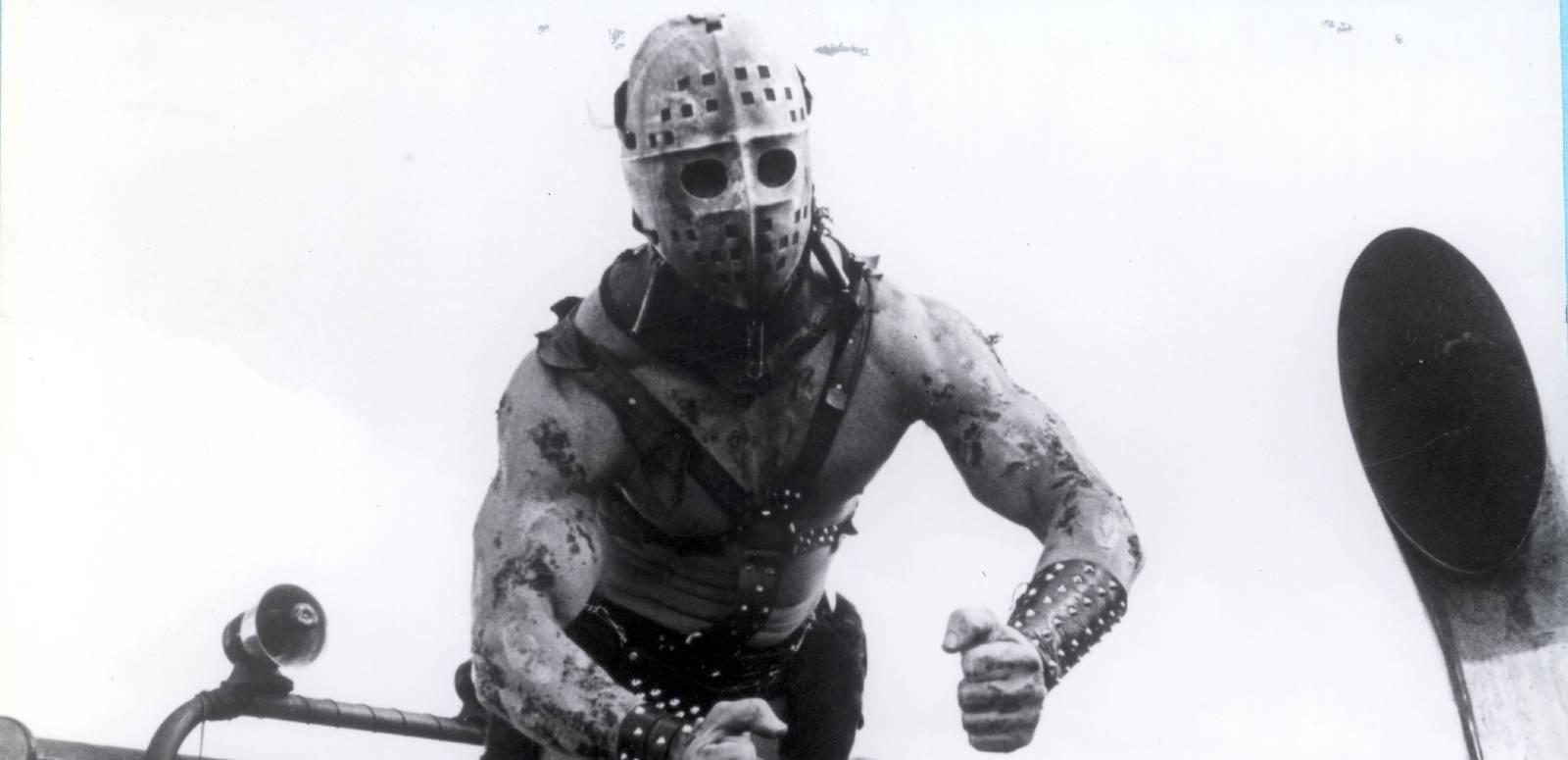
Designer Norma Moriceau drew upon her background as part of the London punk and fashion scene to create the memorable costumes in Mad Max 2 and Mad Max Beyond Thunderdome.
When costume designer Norma Moriceau (1944–2016) came on board for the second and third Mad Max movies, she was building on the punk aesthetic developed by costume designer Clare Griffin, make-up artist Vivien Mepham and director George Miller for Mad Max (1979).
In this clip below, Mepham discusses how the look of the first film was created. With a very limited budget, Mepham recalls ‘leather’ costumes were often plastic, and they used small tattoos and coloured hair to distiguish one gang from another:
Make-up artist Vivien Mepham interviewed by Lorna Lesley (oral history excerpt), 2018. NFSA title: 1537105
For Mad Max 2 (1981), Norma Moriceau took the dystopian wasteland setting to the next level.
Moriceau extended the punk aesthetic and added her own bent, satirical spin. She combined fetish and bondage gear, motorcycle wear and sporting equipment to create detailed looks for every post-apocalyptic character, including the extras.
She helped the actors fill in their narrative backstories in a fashion that has inspired cosplayers ever since. The gallery of Spanish lobby cards for Mad Max 2 below highlights a range of the costumes she created for the movie:
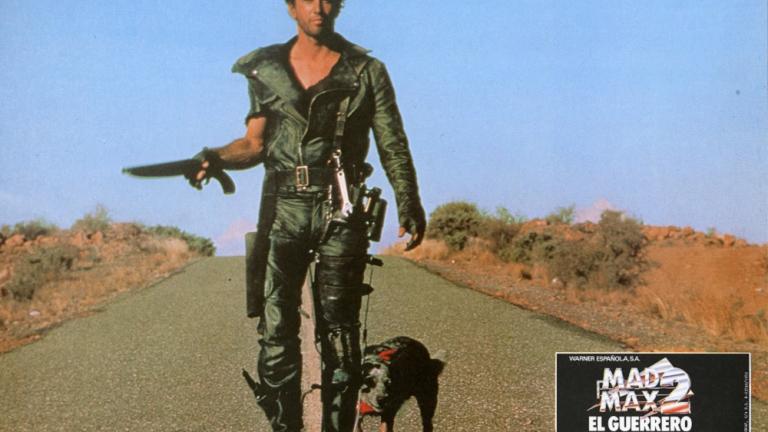
Mad Max 2 Spanish lobby card, 1982. NFSA title: 1178879. Max's jacket had two Rawlings football shoulder pads attached; his trousers had a hinged leg brace from the tailgate of a car and a knee pad from a 1930s cricket pad. Much like the classic western cowboy, here Max is seen as the quintessential loner, a man with a violent past who acts according to his own moral compass. It's an image that sums up the character of Max and was widely used in promotion. Click on image to enlarge.
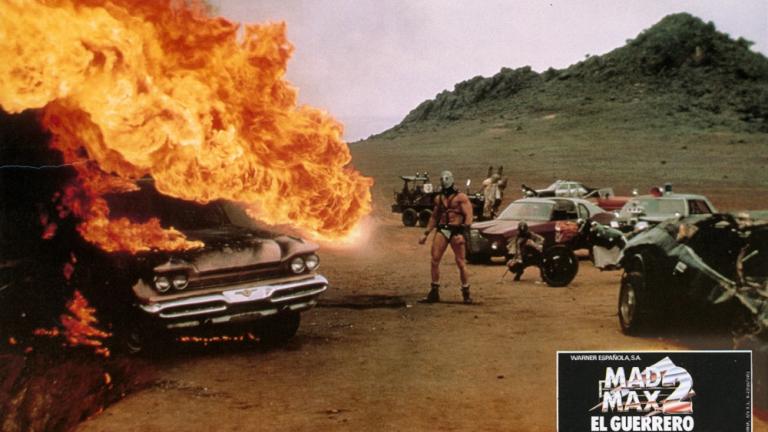
Mad Max 2 Spanish lobby card, 1982: Humungus (Kjell Nilsson). NFSA title: 1178852. Humungus wore an aluminum copy of a Cooper HM6 hockey mask with a cervical collar, leather bondage chest harness, codpiece and lace-up leather gauntlet with cone studs. A very startling image of bare, muscular flesh next to rolling flames capturing the raw intensity of the film. Click on image to enlarge.
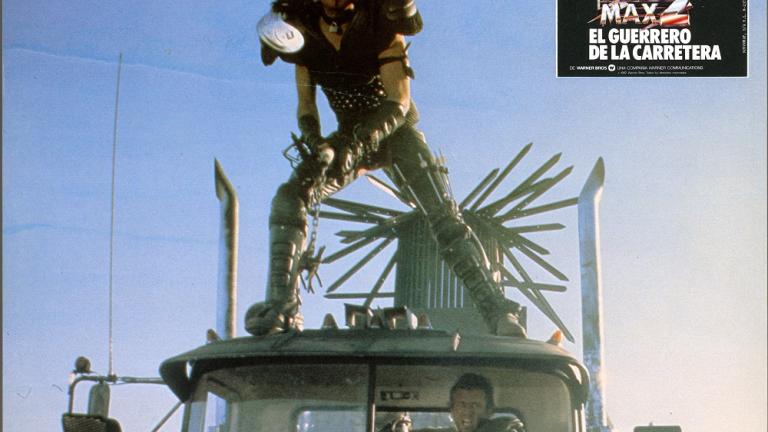
Mad Max 2 Spanish lobby card, 1982: Wez (Vernon Wells) riding on top of a truck cabin. NFSA title: 1178872. Wez's costume included Rawlings Crusader FB-series football shoulder pads and rooster feathers, black leather motorcycle-style chaps and codpiece with one central rear thong. An arresting image demonstrating the risks the cast and crew took to film the more dramatic action sequences. Click on image to enlarge.
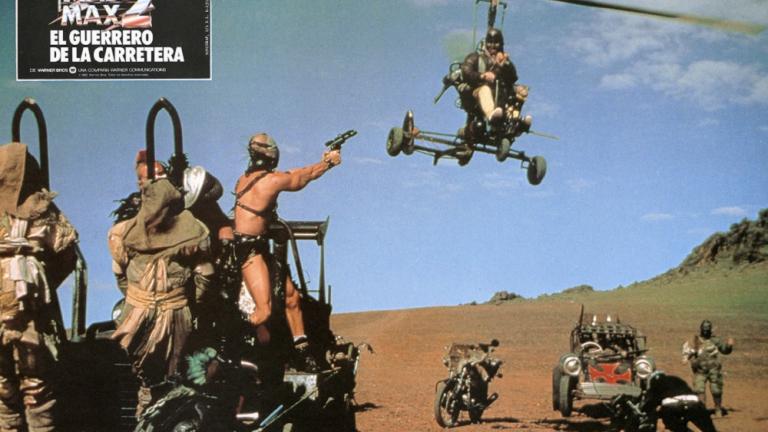
Mad Max 2 Spanish lobby card, 1982: Humungus (Kjell Nilsson) shoots at the Gyro Captain (Bruce Spence). NFSA title: 1183968. The Gyro Captain's goggles were British Royal Air Force Mark IVB with a flip sun-shield. He also wore a fabric-covered groin protector. The Gyro Captain was essentially a comedic character. In this lobby card, his gyrocopter aircraft appears more like an irritating insect to be swatted away than a real threat to the powerful Humungus. Click on image to enlarge.
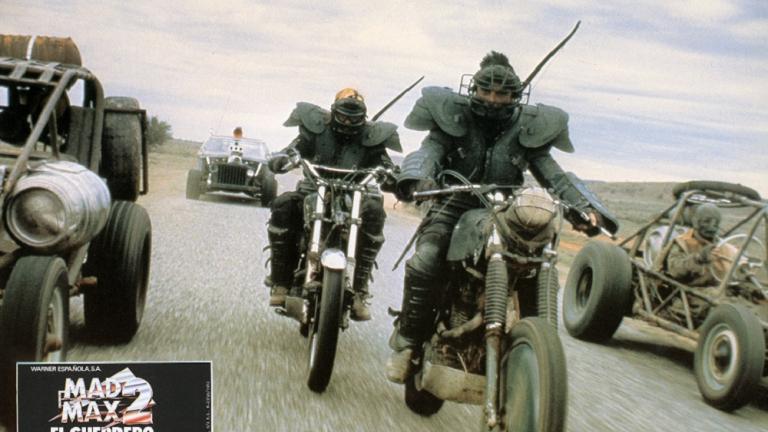
Mad Max 2 Spanish lobby card, 1982: Mohawkers on motorbikes. NFSA title: 1183975. The Mohawkers wore various football shoulder pads, baseball shin-guards on their arms and legs, and codpieces. Their headgear included anything from baseball catchers' masks to swimming goggles and hockey or lacrosse helmets. A wonderful action photo that captures some of the costume design for the subsidiary characters in the film. Click on image to enlarge.
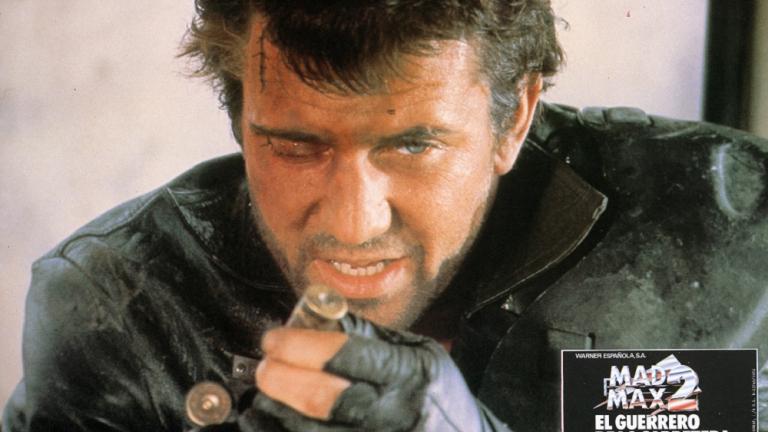
Mad Max 2 Spanish lobby card, 1982: Max (Mel Gibson) holding a bullet. NFSA title: 1178032. A dramatic bloodied and bruised image of Max demonstrates how gritty the second film in the franchise had become. Click on image to enlarge.
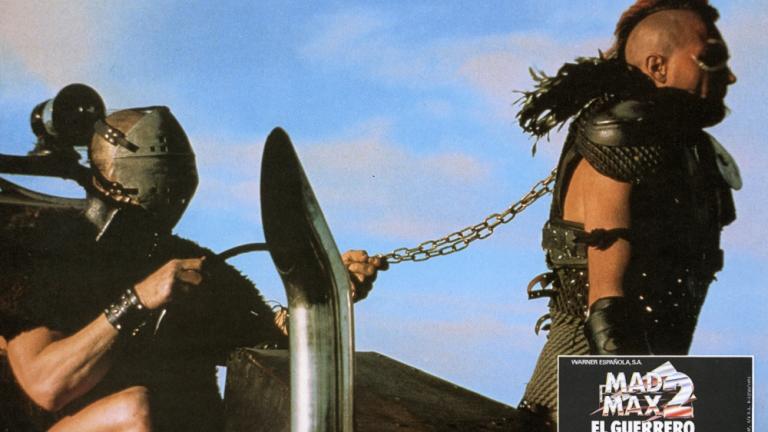
Mad Max 2 Spanish lobby card, 1982: Wez (Vernon Wells) in chains. NFSA title: 1178877. This lobby card successfully illustrates the bestial quality of the film where characters are often more like wild animals than people. Click on image to enlarge.
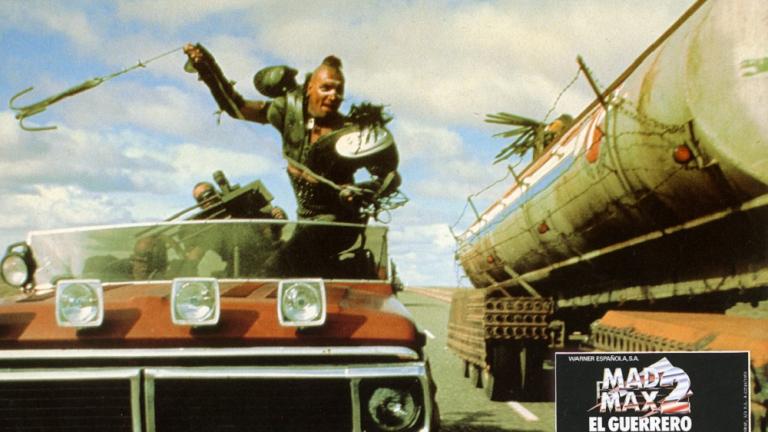
Mad Max 2 Spanish lobby card, 1982: Wez (Vernon Wells) swinging a grappling hook. NFSA title: 1178873. Medieval-style menace meets the post-apocalypse in this lobby card, capturing the dramatic stunts that feature in the film. Click on image to enlarge.
In a Rolling Stone article from 1985, Moriceau coined her approach to costuming the Bartertown guards in Mad Max Beyond Thunderdome (1985) as 'big butch business' and 'male trouble'.
Horse-hair tails, American football shoulder pads, cricket shin pads, car parts (such as mud flaps and hubs), bike reflectors, wartime mens' club medals, chains, protective kidney belts (worn by motorcycle riders), braces, tribal-influenced skins, leather and studs – she assembled them all, with a macho bent. She described the aesthetic in a rare interview for French television magazine show, Les Enfants du Rock (1985).
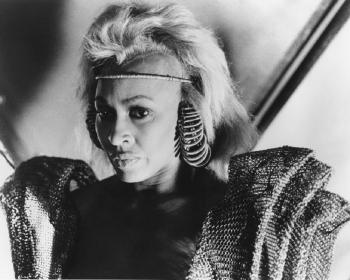
A stand-out costume was the design Moriceau created for Tina Turner's glamazonian Aunty Entity. A sculptural masterpiece described by Rolling Stone magazine as a '32 kg soldered amalgam of dog muzzles, coat hangers and chicken wire, the whole overlaid with gleaming chain-mail butcher aprons and accessorised with pendulant auto-spring earrings'.
As well as solidifying the look for Mad Max, Moriceau also worked on another iconic Australian creation. As costume designer on Crocodile Dundee (1986), she fashioned Paul Hogan's look with its distinctive Akubra hat, shark-tooth necklace and worn leather vest.
In her early teens, Norma Moriceau started her career as a model with June Dally-Watkins before taking herself to London to pursue other opportunities.
In the swinging 60s, she entered the fashion world as photographer, stylist and editor for a string of hip fashion magazines including Nineteen, Vogue and London Life. By the 1970s, she was friends with fashion designer Vivienne Westwood and her partner Malcolm McLaren (they lived around the corner) with whom she often collaborated on film shoots.
She took the iconic photograph of Westwood in her designer 'Destroy' t-shirt, a garment originally sold at Westwood and McLaren’s boutique store Sex and now part of the collection of the Metropolitan Museum of Art in New York. She also worked with Julien Temple on the film The Great Rock’n’Roll Swindle (1980), styling McLaren and the Sex Pistols.
This rare home movie shot by Norma Moriceau in an unknown location captures the artistic and creative scene in which she was immersed, circa 1980:
Norma Moriceau home movie, c.1980. Please note: this clip is silent. Courtesy: Steve Freeth. NFSA title: 1487623
In a tribute to Norma Moriceau at the Australian Production Designers Guild Awards in 2019, director George Miller described Moriceau as 'regal' and 'comprehensive' and as someone who 'dug right deep into character'.
Accepting an award in her honour, Ross Wallace described Moriceau as 'a riddle wrapped up in a mystery, inside an enigma with crocodile teeth and leopard skin and broken-down jackets'.
Costume designer Jenny Beavan, who won an Oscar for her work on Mad Max Fury Road (2015), said she 'was very indebted to Norma Moriceau ... who had accumulated the most amazing collection of junk which was all in boxes at Fox Studios [in Sydney]. I had the whole lot shipped to the Namibian desert where we shot the film.'
Although it is nearly 40 years since Moriceau contributed to Mad Max 2, her work has continued to influence and inspire art, fashion and film worldwide.
With special thanks to Steve Freeth; through his generosity, we acquired boxes of Moriceau’s materials for the NFSA collection in 2016.
Follow the More to Explore links below to see rare clips and behind-the-scenes materials from Mad Max 2 (The Road Warrior) and Mad Max Beyond Thunderdome and Mad Max: Fury Road as well as Mad Max. You can also read about George Miller's Mad Max influences, Brian May's music scores for Mad Max and Mad Max 2 and the work of stunt performers Grant Page and Guy Norris.
The National Film and Sound Archive of Australia acknowledges Australia’s Aboriginal and Torres Strait Islander peoples as the Traditional Custodians of the land on which we work and live and gives respect to their Elders both past and present.